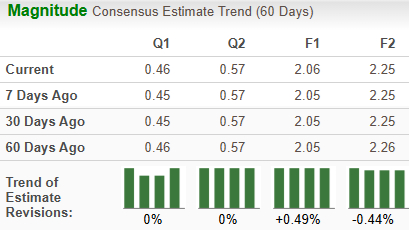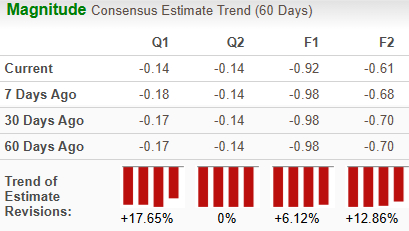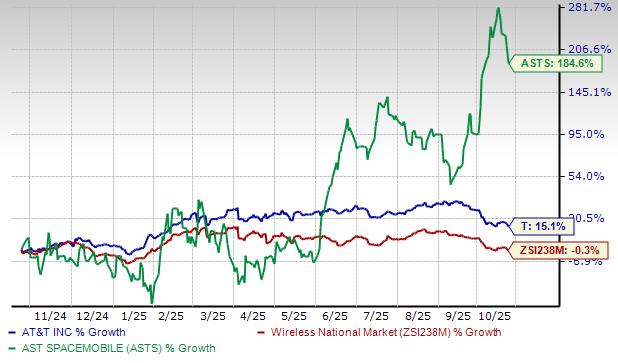|
|
|

|
|||||

|
|
AT&T Inc. T and AST SpaceMobile, Inc. ASTS are two major players in the mobile and wireless-connectivity universe with key expertise in their respective domains. Operating as one of the largest wireless service providers in North America, AT&T offers a vast array of communication and business solutions that include wireless, local exchange, long-distance, data/broadband and Internet, video, managed networking, wholesale and cloud-based services.
AST SpaceMobile is building the world’s first and only global cellular broadband network in space, accessible directly by standard smartphones (4G-LTE/5G devices) for commercial and government use, leveraging its extensive Intellectual Property and patent portfolio. The SpaceMobile Service is provided by a constellation of high-powered, large phased-array satellites in low Earth orbit (LEO) using low-band and mid-band spectrums controlled by Mobile Network Operators (MNOs) in areas lacking terrestrial network coverage.
Let us delve a little deeper into the companies’ competitive dynamics to understand which of the two is relatively better placed in the broader industry.
With a customer-centric business model, AT&T is witnessing healthy momentum in its postpaid wireless business with a lower churn rate and increased adoption of higher-tier unlimited plans. The company remains focused on improving mobile 5G, fixed wireless and edge computing services to drive growth. AT&T is leveraging Ericsson technology to deploy a commercial-scale open radio access network (Open RAN) across the country to help build a more robust ecosystem of network infrastructure providers and suppliers. It is also collaborating with Nokia to streamline network services, improve automation, speed up deployment times and improve operational efficiency.
AT&T has been making several customer-oriented strategies to gain a competitive edge in the industry. It is working with TransUnion to improve customer experiences with branded calling services. AT&T is also collaborating with Microsoft to move its 5G mobile network to the latter’s cloud. The move will enable AT&T to enhance productivity and deliver large-scale network services to meet customers’ needs. The company has introduced AT&T Guarantee, a first-of-its-kind industry initiative that promises to pay bill credits for any network outage across its wireless and fiber networks for consumers and small businesses.
However, despite its effort to reinforce focus on the customer-centric business model with an aim to maintain its customer base, the nationwide wireless service outage that occurred last year has dented customer trust. Moreover, its effort to woo customers with healthy discounts, freebies and cash credits further escalates margin pressures. Stiff competition from Verizon Communications Inc. VZ and T-Mobile US, Inc. TMUS is a headwind. T-Mobile’s strong cash flow position and continuous deployment of mid-band 2.5 GHz spectrum are further intensifying the competition. Declining trends in the wireline business remain a concern.
AST SpaceMobile has deployed its first five commercial satellites (dubbed Bluebird) in LEO, marking a key advancement in developing a space-based mobile network infrastructure. These satellites have the largest-ever commercial communications arrays spanning 693 square feet. They offer non-continuous service across the United States using more than 5,600 cells within the premium low-band spectrum. This achievement follows the success of the company's in-orbit BlueWalker 3 satellite, creating a space-based cellular broadband network that can directly link with mobile devices, eliminating the need for ground-based infrastructure. It plans to deploy 45 to 60 satellites into orbit by the first quarter of 2026. The company boasts a diverse portfolio of more than 3,650 patents and patent-pending claims worldwide for the direct-to-cell satellite ecosystem from space to Earth.
The SpaceMobile service is compatible with all major brands available in the market and connects directly to everyday mobile phones. It delivers broadband connectivity from space to unmodified mobile devices, providing a service to fill cellular coverage gaps in a differentiated approach compared to other space-based communication services. AST SpaceMobile has partnered with leading carriers such as AT&T and Verizon to tap into a pre-existing pool of cell customers and raise funds to help build a worldwide satellite network. This has enhanced cellular coverage in the United States, essentially eliminating dead zones and empowering remote areas of the country with space-based connectivity.
However, unfavorable macroeconomic conditions, including rising inflation, higher interest rates, capital market volatility, tariff imposition and geopolitical conflicts, are negatively impacting the company’s operations. These have led to continued fluctuations in satellite material prices, resulting in increased capital costs and pressure on the company’s financial performance. In addition, AST SpaceMobile faces severe competition from existing and new industry leaders like SpaceX’s Starlink and Globalstar, which are developing satellite communications technology using LEO constellations. To combat such competitive pressure, ASTS has to continuously customize its network offerings, enhance the cost-effectiveness of its products and services and boost its satellite data networks, which increases operating costs and reduces margins.
The Zacks Consensus Estimate for AT&T’s 2025 sales implies year-over-year growth of 2.2%, while that for EPS suggests a decline of 8.8%. The EPS estimates have been trending northward (up 0.5%) over the past 60 days.

The Zacks Consensus Estimate for AST SpaceMobile’s 2025 sales implies year-over-year growth of 1,120%, while that for EPS suggests a decline of 39.4%. The EPS estimates have been trending northward (up 6.1%) over the past 60 days.

Over the past year, AT&T has gained 15.1% against the industry’s decline of 0.3%. AST SpaceMobile has gained 184.6% over the same period.

AT&T looks more attractive than AST SpaceMobile from a valuation standpoint. Going by the price/sales ratio, AST SpaceMobile’s shares currently trade at 115.36 forward sales, significantly higher than 1.45 for AT&T.

While AT&T has a Zacks Rank #3 (Hold), AST SpaceMobile has a Zacks Rank #5 (Strong Sell).
You can see the complete list of today’s Zacks #1 Rank (Strong Buy) stocks here.
Both AT&T and AST SpaceMobile expect sales to improve in 2025, although the latter’s growth expectations far exceed those of the former. AST SpaceMobile boasts a better price performance, although AT&T has comparatively more attractive valuation metrics. With a better Zacks Rank, solid subscriber momentum over the past few months and extensive network modernizations, AT&T appears to be relatively better placed than AST SpaceMobile. Consequently, AT&T is a better investment option at the moment.
Want the latest recommendations from Zacks Investment Research? Today, you can download 7 Best Stocks for the Next 30 Days. Click to get this free report
This article originally published on Zacks Investment Research (zacks.com).
| Dec-02 | |
| Dec-02 | |
| Dec-02 | |
| Dec-02 | |
| Dec-02 | |
| Dec-02 | |
| Dec-02 | |
| Dec-01 | |
| Dec-01 | |
| Dec-01 | |
| Dec-01 |
T-Mobile Launches Most Aggressive Black Friday Wireless Promotion
TMUS VZ T
Investor's Business Daily
|
| Dec-01 | |
| Nov-29 | |
| Nov-29 | |
| Nov-28 |
T-Mobile Launches Most Aggressive Black Friday Wireless Promotion
TMUS VZ T
Investor's Business Daily
|
Join thousands of traders who make more informed decisions with our premium features. Real-time quotes, advanced visualizations, backtesting, and much more.
Learn more about FINVIZ*Elite